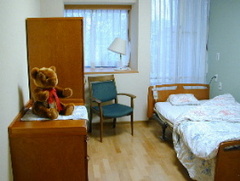
Feb 17, 2023
- Products & Solutions
- Feature Story
- R&D
- Business Solution
- Electronic Materials/Devices

First, let's ask a basic question. What are robots? Robots were first presented in a Czech language science fiction play called "R.U.R. (Rossum's Universal Robots) in 1920 and can be said as the closest concept to the modern idea of androids. Since then, robots have been introduced in a variety of shapes and forms, "Astro Boy", "Doraemon", "Gundam", "C-3PO" or "R2-D2" to name a few. Their appearances have helped give people hope and dreams to a new future supported by robots.

That is exactly the dream Panasonic had when it first began robotics development. The first robot Panasonic developed was a "teddy bear-like" pet robot about twelve years ago and was introduced in a nursery institute in Osaka to help care for elderly people mentally. Since then, Panasonic has continued to find new ways to design robots that assist people, proposing various types of robots such as a forklift style robot, a power assist robot and so forth. You can see some of those highlighted in our previous article.
In the latest announcement, Panasonic has unveiled a new concept robot, HOSPI-Rimo, and also two new upgrades to its existing robots, the Hair-Washing Robot and RoboticBed®. All of these robots will help the aged and/or handicapped lead an ordinary life.
HOSPI-Rimo serves as an intermediary to enable face to face communication even when one is lying on the bed at a hospital and cannot easily communicate with others. Watching over patients with a friendly humanistic face, HOSPI-Rimo aims to bring warmth even to nervous patients. But this face can also be seen as a disguise, as its function is to act as a strong inspection tool making note of ones' changes and notifying the doctors if consultation may be required.
Here are some of technological breakthroughs of HOSPI-Rimo:
Wouldn't it be wonderful if you could easily wash your hair while hospitalized with a broken arm? This can become possible with Panasonic's Hair-Washing Robot which it announced last year as its latest robotic development. In the most updated model, Panasonic's Hair-washing robot features 24 dexterous fingers which can lather up the scalp with shampoo, rinse and condition and even dry the patients hair! The 24 fingers move and press to the scalp independently via individual sensors that determine the size of the head and fit perfectly to realise the most comfortable hair-washing even when hospitalized. The washing robot settings can be changed and stored in the memory of the robot so that individual patients can wash and rinse their hair without the fuss of setup each time.
For handicapped or elderly persons, one of the stresses that one has to battle is the difficulty of moving around individually without asking for help; once simple movements such as sitting up from bed suddenly become very challenging and frustrating tasks. And the RoboticBed was aimed to solve this stress. The RoboticBed can transform from a bed to a wheelchair with a voice recognition system and then the wheelchair can be controlled electronically via a controller on the armrest. This year, Panasonic has further improved the interface of the bed to make the reclining of the bed smoother and also the movement of the wheelchair more precise.
Although the robots that Panasonic is developing are still undergoing prototype testing, we aim to make these products available for use in hospitals and care centers as soon as possible.
The content in this website is accurate at the time of publication but may be subject to change without notice.
Please note therefore that these documents may not always contain the most up-to-date information.
Please note that German, French and Chinese versions are machine translations, so the quality and accuracy may vary.